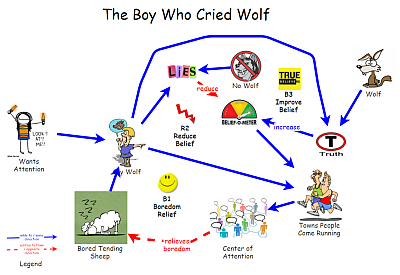
Developing understanding: Models 1-2 [Systems thinking & modelling series]
This is part 9 of a series of articles featuring the book Beyond Connecting the Dots, Modeling for Meaningful Results.
In this section we will present a number of models to demonstrate the development process, discuss various aspects of the model development guidelines, and acquaint you with additional relevant aspects of simulation models in Insight Maker.
The Boy Who Cried Wolf
All stories are actually models expressed in words rather than diagrams. All of the interactions in a story can be expressed in the form of a model, which provides an overview of the main interactions in a single picture. “The Boy Who Cried Wolf” will unfold a model as a story and show the difference between a Rich Picture and a Causal Loop Diagram for the same story.
Telling a story as you unfold a model.
Need help? See the Model instructions
Just as all stories are models, you should ensure that models you develop actually tell a story. Telling stories makes it easier to communicate to others the insights surfaced in the model, and stories are much easier to remember than bits and pieces of data.
Walking to Grandma’s
When you develop a model remember that it’s a learning process, so don’t expect everything to turn out the way it should the first time around. Remember to think of it as an iterative learning process. When something doesn’t go the way you expected, don’t think of it as error; it’s an opportunity for learning.
“Walking to Grandma’s” is a simple example of a question that might be answered with a model. And yes, obviously you could just do the math, but would you get better at building models if you did? This model also introduces the idea of Units, which are used to help ensure the soundness of your model. Insight Maker checks Units to make sure you’re not trying to perform invalid arithmetic, such as adding 3 apples and 4 bananas.
How long will it take us to get there?
Need help? See the Model instructions
| Exercise 2-1 |
|---|
| In the [Stop at Grandmas] variable, change {0 miles} to {0 kilometers} – does the model still work? Why? |
Seldom is there ever just one way to build a model. You build the model to help you understand something and you might do that in different ways. Even a model as simple as Going to Grandma’s can be structured in several ways other than starting with a stock of 4.5 and reducing it by walking.
| Exercise 2-2 |
|---|
| Go to Insight Maker and try to build one or two alternatives to this model. |
Hopefully Going to Grandma’s has reinforced the ‘build a little, test a little’ approach for developing models. The introduction to using units should have provided a sense of why they can be so useful. Oh, and don’t forget about putting notes in your models. Wiring diagrams without a description of the pieces are generally not very useful.
Next edition: Developing understanding: Models 3-4.
Article sources: Beyond Connecting the Dots, Insight Maker. Reproduced by permission.
Header image source: Beyond Connecting the Dots.







